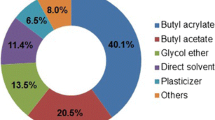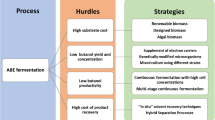Abstract
China is one of the few countries, which maintained the fermentative acetone–butanol–ethanol (ABE) production for several decades. Until the end of the last century, the ABE fermentation from grain was operated in a few industrial scale plants. Due to the strong competition from the petrochemical industries, the fermentative ABE production lost its position in the 1990s, when all the solvent fermentation plants in China were closed. Under the current circumstances of concern about energy limitations and environmental pollution, new opportunities have emerged for the traditional ABE fermentation industry since it could again be potentially competitive with chemical synthesis. From 2006, several ABE fermentation plants in China have resumed production. The total solvent (acetone, butanol, and ethanol) production capacity from ten plants reached 210,000 tons, and the total solvent production is expected to be extended to 1,000,000 tons (based on the available data as of Sept. 2008). This article reviews current work in strain development, the continuous fermentation process, solvent recovery, and economic evaluation of ABE process in China. Challenges for an economically competitive ABE process in the future are also discussed.







Similar content being viewed by others
References
Chiao JS, Sun ZH (2007) History of the acetone–butanol–ethanol fermentation industry in China: development of continuous production technology. J Mol Microbiol Biotechnol 13:12–4
Chiao JS, Zheng YX, Shen YQ (1960) Studies on acetone-butanol continuous fermentation and production. Shanghai Science Proceedings,pp 1–23 (in Chinese)
Desai RP, Papoutsakis ET (1999) Antisense RNA strategies for metabolic engineering of Clostridium acetobutylicum. Appl Environ Microbiol 65:936–945
Dürre P (2008) Fermentative butanol production: bulk chemical and biofuel. Ann N Y Acad Sci 1125:353–362
Dyr J, Munk V (1954) Biosynthesis of riboflavin by Clostridium acetobutylicum. Chekhoslovatskaia Biol 3:23–29
Ezeji T, Qureshi N, Blaschek HP (2007a) Butanol production from agricultural residues: Impact of degradation products on Clostridium beijerinckii growth and butanol fermentation. Biotechnol Bioeng 97:1460–1469
Ezeji TC, Qureshi N, Blaschek HP (2007b) Bioproduction of butanol from biomass: from genes to bioreactors. Curr Opin Biotechnol 18:220–227
Green EM, Boynton ZL, Harris LM, Rudolph FB, Papoutsakis ET, Bennett GN (1996) Genetic manipulation of acid formation pathways by gene inactivation in Clostridium acetobutylicum ATCC 824. Microbiology 142:2079–2086
Harris LM, Blank L, Desai RP, Welker NE, Papoutsakis ET (2001) Fermentation characterization and flux analysis of recombinant strains of Clostridium acetobutylicum with an inactivated solR gene. J Ind Microbiol Biotechnol 27:322–328
Heap JT, Pennington OJ, Cartman ST, Cartera GP, Minton NP (2007) The ClosTron: a universal gene knock-out system for the genus Clostridium. J Microbiol Meth 70:452–464
Jones DT, Woods DR (1986) Acetone–butanol fermentation revisited. Microbiol Rev 50:484–524
Jones DT, Keis S (1995) Origins and relationships of industrial solvent-producing clostridial strains. FEMS Microbiol Rev 17:223–232
Karakashev D, Thomsen AB, Angelidaki I (2007) Anaerobic biotechnological approaches for production of liquid energy carriers from biomass. Biotechnol Lett 29:1005–1012
Lee SY, Park JH, Jang SH, Nielsen LK, Kim J, Jung KS (2008) Fermentative butanol production by Clostridia. Biotechnol Bioeng 101:209–228
López-Contreras AM, Claassen PA, Mooibroek H, De Vos WM (2000) Utilisation of saccharides in extruded domestic organic waste by Clostridium acetobutylicum ATCC 824 for production of acetone, butanol and ethanol. Appl Microbiol Biotechnol 54:162–167
López-Contreras AM, Smidt H, van der Oost J, Claassen PA, Mooibroek H, de Vos WM (2001) Clostridium beijerinckii cells expressing Neocallimastix patriciarum glycoside hydrolases show enhanced lichenan utilization and solvent production. Appl Environ Microbiol 67:5127–5133
Lynd L (1989) Production of ethanol from lignocellulosic materials using thermophilic bacteria: Critical evaluation of potential and review. In: Advances in Biochemical Engineering/Biotechnology, vol 38. Springer, Berlin, pp 1–52
Lynd LR, van Zyl WH, McBride JE, Laser M (2005) Consolidated bioprocessing of cellulosic biomass: an update. Curr Opin Biotech 16:577–583
Liu Y, Liu HJ, Zhang JA, Cheng KK, Chen ZD (2008) Research progress in new biofuel butanol. Mod Chem Ind 28:28–33 (in Chinese)
Mays T (2008) DuPont and BP disclose advanced biofuels partnership targeting multiple butanol molecules. Available via DIALOG. http://www2.dupont.com/EMEA_Media/en_GB/newsreleases_2008/article20080214.html. Accessed 14 Feb 2008
Nair RV, Green EM, Watson DE, Bennett GN, Papoutsakis ET (1999) Regulation of the sol locus genes for butanol and acetone formation in Clostridium acetobutylicum ATCC 824 by a putative transcriptional repressor. J Bacteriol 181:319–330
Nimcevic D, Gapes JR (2000) The acetone–butanol fermentation in pilot plant and pre-industrial scale. J Mol Microbiol Biotechnol 2:15–20
Qureshi N, Saha BC, Cotta MA (2007) Butanol production from wheat straw hydrolysate using Clostridium beijerinckii. Bioprocess Biosyst Eng 30:419–427
Shao L, Hu S, Yang Y, Gu Y, Chen J, Yang YL, Jiang WH, Yang S (2007) Targeted gene disruption by use of a group II intron (targetron) vector in Clostridium acetobutylicum. Cell Res 17:963–965
Shen PZ, Ren C (2005) Demand forecast about the production and market of butyl alcohol and octyl alcohol. Chem Ind Eng Progr 24:216–220 (in Chinese)
Sun ZH (1981) The design and technology of acetone–butanol continuous fermentation. Ind microbiol 11:31–37 (in Chinese)
Sun ZH (1987) A method of acetone-butanol production by directly fermenting starch materials with absorbed immobilized cells. Chinese patent CN 87103534
Sun ZH, Chiao JS (2003) Microbiological engineering: acetone–butanol. Chemical Industry, Beijing, pp 148–156 in Chinese
Woods DR (1995) The genetic engineering of microbial solvent production. Trends Biotechnol 13:259–264
Zhang Y, Yang YL, Chen J, Chiao RS (1995) A Clostridium acetobutylicum strain with high butanol ratio, methods for cultivation, and its application. Chinese patent CN1143677
Zhang YF, Chen J, Yang YL, Chiao JS (1996) The screening and application of the Clostridium acetobutylicum with high butanol ratio. Ind microbiol 26:1–6 (in Chinese)
Zverlov VV, Berezina O, Velikodvorskaya GA, Schwarz WH (2006) Bacterial acetone and butanol production by industrial fermentation in the Soviet Union: use of hydrolyzed agricultural waste for biorefinery. Appl Microbiol Biotechnol 71:587–597
Acknowledgments
The authors would like to thank Professor George Bennett (Rice University, Houston, Texas) for comments, suggestions, and critically reading the manuscript. Help from Professors Weihong Jiang and Sheng Yang (Shanghai Institutes for Biological Sciences, Chinese Academy of Sciences) is gratefully acknowledged.
Author information
Authors and Affiliations
Corresponding author
Rights and permissions
About this article
Cite this article
Ni, Y., Sun, Z. Recent progress on industrial fermentative production of acetone–butanol–ethanol by Clostridium acetobutylicum in China. Appl Microbiol Biotechnol 83, 415–423 (2009). https://doi.org/10.1007/s00253-009-2003-y
Received:
Revised:
Accepted:
Published:
Issue Date:
DOI: https://doi.org/10.1007/s00253-009-2003-y




